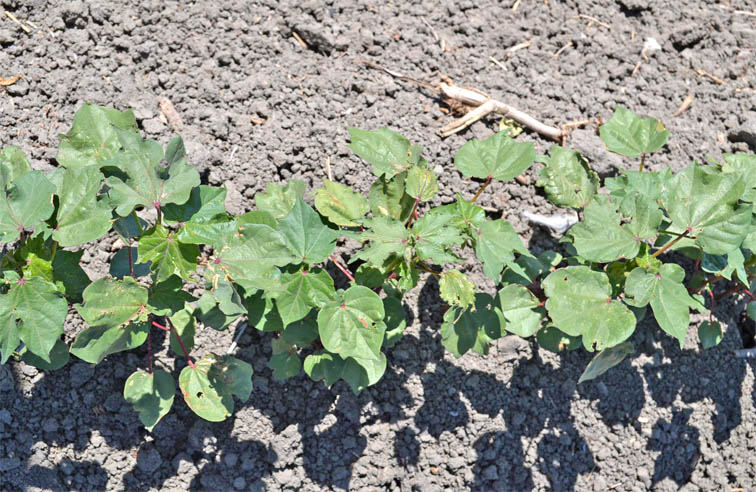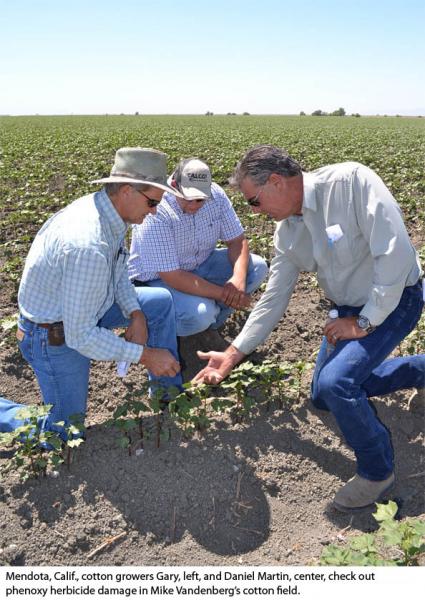
At least 15,000 acres of San Joaquin Valley cotton and one young pomegranate orchard have been damaged by phenoxy herbicide drift from a legal, but questionable Merced County, Calif., 2,4-D application to pasture land.It was an application that would have been illegal in Fresno, Tulare, Kings, Kern and Madera counties.
June 14, 2012

At least 15,000 acres of San Joaquin Valley cotton and one young pomegranate orchard has been damaged by phenoxy herbicide drift from a legal but questionable Merced County, Calif. 2,4-D application to pasture land.
According to Cannon Michael, vice president of Bowles Farming in Los Banos, Calif., the Merced County agricultural commissioner granted a variance for a 1,000-acre 2,4-D application. It was an application that would have been illegal in Fresno, Tulare, Kings, Kern and Madera counties where no 2, 4-D may be applied after March 16 because of the risk of injury to newly planted cotton and leafing out trees and vines.
Officials are continuing to assess the damage of the early June application of the herbicide, but so far injury has been verified as far south as Kern County, according to Fresno County deputy agricultural commissioner Les Wright.
Wright verified the Kern County damage 100 miles away from the suspect Merced County application site at a San Joaquin Sustainable Farming Project cotton field day near Firebaugh, Calif., adjacent to a field that had been hit by the drift.
It was Mike Vandenberg’s farm where the field day was held and he said the damage is spotty in the field, but evident. He is concerned about the long-term effect of the phenoxy herbicide drift on this year’s yield.
 Dan Munk, University of California cotton farm advisor, demonstrated the crinkled leaf symptoms of phenoxy damage. However, Munk said in a tour of damaged fields prior to the field day, he saw no square damage.
Dan Munk, University of California cotton farm advisor, demonstrated the crinkled leaf symptoms of phenoxy damage. However, Munk said in a tour of damaged fields prior to the field day, he saw no square damage.
“Cotton is extremely sensitive to phenoxy herbicides,” he said.
Paul Goodman, a Dos Palos, Calif., cotton producer, can vouch for that. Several years ago, 50 acres of seedling cotton he was farming was scorched by 2,4-5 residue in an aerial applicator’s tanks. “It virtually defoliated the field. I was ready to disk it under and start over. The insurance company said to leave the field in and I would be compensated for any yield loss,” he said.
Goodman said, “The field actually yielded more than undamaged fields. When the season was over a bunch of my fellow growers teased me and asked if I would treat their cotton with this growth regulator next season.”
Munk acknowledged that 2,4-D is actually a growth regulator that can effect different varieties differently.
Goodman said the swelling controversy is much ado about nothing. His comments were heartening to those at the field day who are seeing damage, but the issue is far from resolved.
Wright said the amount of damage lessens the farther south you go from the application site in Merced County. “It may be one in three plants the closer you are to the (suspect) application area. In the Firebaugh area and south it may be only one in 10 plants.” However, he cautioned that county and state officials are continuing to evaluate the situation. He said there may have been more than just one incident on one day. Wright acknowledged that the application was “somewhat” legal. However, growers and others are questioning the wisdom in approving the permit.
Drift on windy, hot day
One grower at the cotton field day said he has lost 50 acres of young pomegranates to the drift and wanted to know where to file a claim. Phenoxy herbicide can also damage grapevines.
“I am upset that the (Merced) county would grant a variance for 1,000 acres of 2,4-D in June,” said Michael, who has tallied damage to 1,700 acres at least at Bowles. “I know the applicator was at fault too, but the county put the loaded gun in his hands.”
“If I had done something like that, we could potentially go out of business. The county needs to change their policy on granting late sprays of 2,4-D. There is no reason to take such a risk to spray a pasture when there are so many sensitive plants up and growing.”
2,4-D is a well-known, expensive and effective herbicide that is widely used on winter wheat and even in dormant orchards and vineyards for weed control.
“I don't want the material taken away, but it needs to be used at the appropriate times,” said Michael.
The suspect application took place on a windy, hot day — two of the biggest factors that contribute to drift of the highly volatile herbicide. “The heat is equally as dangerous as the wind,” Michael commented. Those conditions could have created an inversion that could move the herbicide well off-site, he said.
Wright, Munk and Michael all cautioned growers to watch how the cotton reacts to the damage. It could well grow out of the damage as Goodman indicated, but Munk added that the herbicide could remain in the vascular system of the plant.
“We need a week to 10 days to see how plants grow out of it. Bill Weir (UC Merced farm advisor emeritus) thought it looked like 15 to 20 percent in yield reduction,” Michael said.
Years ago, 2,4-D drift was a common problem within and outside the valley, drifting into the valley from as far away as the wheat fields on the Central Coast. That is why the March 16 cutoff date was established.
About the Author(s)
You May Also Like





